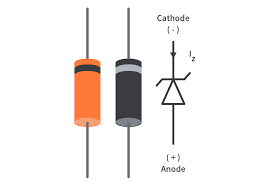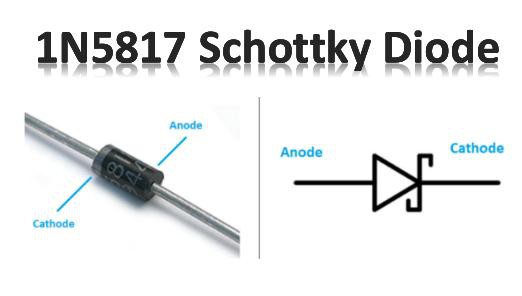Diodes are electrical components with two terminals and one-way current flow. The diode's ability to only allow the electric current to travel in one direction is well-known. When you need to rectify a waveform, you can use a diode in a radio detector or a power supply. Additionally, they can be employed in various electronic and electrical circuits when the diode's unidirectional outcome is necessary.
Most diodes are composed of semiconductors like silicon (Si), but germanium (Ge) is also occasionally utilized. Sometimes it helps to list the various kinds of diodes that are available. Even though some of the kinds may overlap, the multiple definitions may help to focus the discussion and provide a general summary of the many diode types.
Different Types of Diodes
Now let's quickly review a few popular diode types.
1. Small Signal Diode
It's a tiny gadget with disproportionate features, used in various low-current and high-frequency devices like radios, TVs, and computers. You can also refer to this diode as a Glass Passivated Diode since it is sealed in glass to prevent contamination. The 1N4148 is a typical example of such a diode.

Signal diodes appear much smaller than power diodes from a visual standpoint. One edge is colored red or black to denote the cathode terminal. The tiny signal diode performs exceptionally well for high-frequency applications.
2. Large Signal Diode
The PN junction layer is thick on these diodes. Therefore, they are frequently used in rectification or converting AC to DC. The big PN Junction also boosts the diode's ability to carry forward current and reverse blocking voltage. Diodes with such a significant signal current aren't for use at high frequencies. The 1N4007 is a well-known diode of this kind.

These diodes are essential in a variety of Power Supply applications. Diodes with high reverse blocking resistance often have forward resistance values in the micro- to the mega-Ohm range. This high voltage and current capability make it suitable for electrical appliances designed to dampen excessively high peak voltages.
3. Zener Diode
It's a passive component that operates according to the "Zener Breakdown" theory. It was created for the first time by Clarence Zener in 1934, and in a forward bias condition, like a conventional diode, it permits current to pass.

However, the diode does not conduct under reverse bias conditions until the applied voltage approaches the Zener Breakdown voltage. It can guard against brief voltage pulses that could damage other semiconductor gadgets. It controls the voltage.
4. Light Emitting Diode (LED)
These diodes produce light energy by converting electrical energy. The initial production began in 1968. When placed in a forward bias, it emits light via an electroluminescence procedure whereby energy holes are converted to electrons.

LEDs were initially exceedingly expensive and mainly utilized in specialized applications. However, the price of LEDs has decreased dramatically over time. As a result, LEDs have replaced incandescent bulbs in almost every application where artificial light is required, including homes, workplaces, streets, cars, and smartphones.
5. Constant Current Diodes

People sometimes refer to it as a diode-connected transistor, current-regulating diode, or current-limiting diode. Diodes can control voltage at a specific current. Useful as a current restrictor with two connections, it. In this case, the JFET limits the amount of current so that the output impedance is high.
6. Schottky Diode
These diodes have a junction produced when you bring metal into contact with semiconductors. The forward voltage loss reduces to a minimum due to this. N-type silicon is the anode, whereas metals, including Chromium, Tungsten, and Platinum, are the cathodes.

The Schottky diode has a shorter switching time because of its metal junction's large current conducting capabilities. As a result, the Schottky diode is best suited for use in switching functions. Diode efficiency is improved, and power loss is minimized, mostly due to the metal-semiconductor junction. For this reason, these find utility in high-frequency rectifier circuits.
7. Shockley Diode
It was among the earliest semiconductor technology ever created. Four layers make up a Shockley Diode. It also goes by the name PNPN diode. It is the same as if the gate terminal of a thyristor were disconnected, making it ineffective. The sole method the diode could conduct because there isn't any trigger input is by applying forward voltage.

As soon as it is turned "ON" or "OFF," it remains in either state. Both non-conducting and conducting are possible operational states for a diode. Less voltage is required for the diode to conduct when it is not.
8. Step Recovery Diodes
It is a diode that can store electrical charges and be easily detached. These unique diodes can convert the positive pulse energy into the negative pulse power used in sinusoidal communications. In this pulse, the increased time coincides with the snap. You can use these diodes in circuits for pulse shapers and higher-order multipliers. They have a high cut-off frequency, almost in the gigahertz range.
9. Tunnel Diode
The nanoseconds-scale switching speeds make it ideal for high-speed switching. Because of the tunneling effect, it operates exceptionally quickly in the microwave frequency range. High dopant concentrations are in a two-terminal gadget.

Junction capacitance, as well as errant wire capacitance, are limiting the transient performance. Amplifiers and oscillators for microwaves are the main applications. It performs the most negative conductance function. You can use both electrical and mechanical tuning methods with tunnel diodes.
10. Varactor Diode
You can also refer to it as varicap diodes. It works like variable capacitors. These diodes are well-known for their capacity to alter capacitance limits inside a circuit while maintaining a steady voltage supply.

Capacitance could be varied to extremely high values. Varactor diodes allow us to adjust the thickness of the depletion layer by adjusting the magnitude of the reverse bias voltage. Numerous devices use these diodes as voltage-controlled oscillators, including satellite pre-filters and mobile phones.
Conclusion
Diodes are electrical components with just a direction of current flow possible due to their two terminals. Various semiconductors, including Silicon, Gallium Arsenide, and Germanium, are crucial when producing these diodes.
Diodes come in various varieties, each with its own voltage needs. In contrast to Germanium diodes, which have a forward voltage of 0.3V, Silicon diodes require 0.7V. Typically, the black band on one end of a silicon diode designates the cathode terminal while the other terminal represents the anode.
Discussions
Become a Hackaday.io Member
Create an account to leave a comment. Already have an account? Log In.